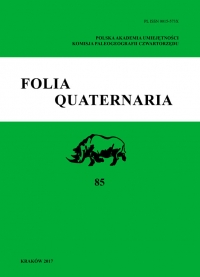Plant exploitation by the inhabitants of the Wielbark culture settlement complex near the village Ulów, SE Poland, at the background of the natural environment
Plant exploitation by the inhabitants of the Wielbark culture settlement complex near the village Ulów, SE Poland, at the background of the natural environment
Author(s): Irena Agnieszka Pidek, Krystyna Wasylikowa, Magdalena Moskal-del HoyoSubject(s): Archaeology
Published by: Wydawnictwo Uniwersytetu Jagiellońskiego
Keywords: pollen analysis; fruits; seeds; wood charcoals; Wielbark culture; Roman period; Roztocze; Poland;
Summary/Abstract: Palynological and archaeobotanical investigations were carried out on a large settlement complex of the Wielbark culture dated to the late Roman and early Migration periods, situated near the village Ulów in the Middle Roztocze, SE Poland. Pollen diagrams which covered the Subboreal and Subatlantic periods revealed the development of forests with European hornbeam Carpinus betulus, lime Tilia sp., oak Quercus sp. and common beech Fagus sylvatica in the Subboreal and the spread of silver fir Abies alba in the Subatlantic phase. Pollen spectra from both periods provided the evidence of cereal cultivation and animal grazing in the neighbourhood of the settlement. The analysis of daub coming from the Wielbark culture features documented the predominance of common barley Hordeum vulgare and common millet Panicum miliaceum among the cereals and probably lesser significance of wheat, emmer Triticum dicoccon or einkorn T. monococcum. Charcoal assemblages were examined from the settlement and from the cemetery. Taking into account the number of charcoal fragments, Quercus sp. was the most abundant taxon, followed by Fagus sylvatica, Carpinus betulus, Scots pine Pinus sylvestris, and birch Betula sp. Other taxa were only occasionally found. The taxonomic lists were very similar in the settlement and the cemetery, but there was a discrepancy between the predominating taxa since birch was the most frequent at the cemetery and oak in the settlement.
Journal: Folia Quaternaria
- Issue Year: 2017
- Issue No: 85
- Page Range: 81-108
- Page Count: 28
- Language: English

